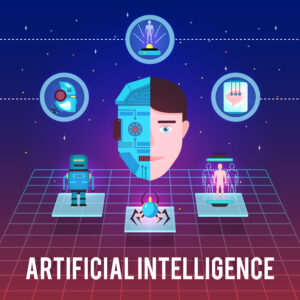Introduction
Artificial Intelligence (AI) has emerged as one of the most transformative technologies of the 21st century. From its inception in the mid-20th century to its current applications across various sectors, AI has made significant strides, reshaping the way we live and work. This article delves into the evolution of AI, its various branches, applications across industries, ethical considerations, and future prospects, ultimately highlighting the profound impact AI has on society.
1. The Historical Context of AI
The roots of artificial intelligence can be traced back to ancient history, where myths and legends about intelligent beings and automata existed. However, the formal study of AI began in the 1950s, marking a pivotal turning point in technology.
- The Dartmouth Conference (1956): This seminal event is often regarded as the birth of AI as a field. Researchers like John McCarthy, Marvin Minsky, Nathaniel Rochester, and Claude Shannon convened to discuss the potential of machines to simulate human intelligence. The conference set the stage for future AI research, generating interest and funding.
- Early Developments: The 1960s and 1970s saw the development of early AI programs, such as ELIZA, a natural language processing program that simulated conversation. These initial efforts, while groundbreaking, faced limitations due to the lack of computational power and understanding of intelligence, leading to the first AI winter in the late 1970s.
- Resurgence and Growth: The 1980s marked a resurgence in AI research, fueled by advances in computational power and the development of expert systems. These systems used rule-based logic to solve specific problems, finding applications in fields like medicine and finance.
- The Internet Age: The advent of the internet in the 1990s provided a massive influx of data, enabling machine learning algorithms to thrive. This era saw the emergence of AI-driven applications like search engines and recommendation systems, laying the groundwork for the AI landscape we see today.
2. The Branches of AI
AI can be broadly categorized into several branches, each with its unique focus and methodology:

- Machine Learning (ML): A subset of AI that emphasizes the use of algorithms allowing computers to learn from and make predictions based on data. ML has gained prominence with the advent of big data and improved computational capabilities. Techniques such as supervised learning, unsupervised learning, and reinforcement learning are essential components of ML.
- Deep Learning: A further subset of ML that utilizes neural networks with many layers (deep networks) to analyze complex data patterns. Deep learning has revolutionized fields such as image and speech recognition, enabling breakthroughs in tasks that were previously considered too complex for machines.
- Natural Language Processing (NLP): This branch focuses on enabling machines to understand and respond to human language. NLP encompasses a range of tasks, including text analysis, sentiment analysis, language translation, and conversational agents (chatbots).
- Computer Vision: This field allows machines to interpret and understand visual information from the world. Computer vision has applications in facial recognition, autonomous vehicles, medical image analysis, and augmented reality.
- Robotics: AI in robotics involves creating machines that can perform tasks autonomously. This includes everything from industrial robots in manufacturing to drones used for delivery and surveillance.
- Expert Systems: These are AI programs that mimic the decision-making abilities of a human expert. They use a knowledge base and inference rules to solve specific problems, often in fields like medicine and finance.
- Reinforcement Learning: A branch of ML where an agent learns to make decisions by taking actions in an environment to maximize cumulative rewards. This approach has been successfully applied in game playing, robotics, and autonomous systems.
3. Current Applications of AI
AI is now integrated into numerous industries, enhancing efficiency, accuracy, and innovation. Its applications span across various sectors, including:

- Healthcare: AI is transforming healthcare through predictive analytics, personalized medicine, and robotic surgery. For instance, AI algorithms analyze medical data to predict patient outcomes and suggest treatment options. In radiology, AI systems can accurately identify anomalies in medical images, assisting radiologists in diagnosis.
- Finance: In the financial sector, AI is used for fraud detection, algorithmic trading, risk management, and customer service through chatbots. AI systems analyze vast amounts of transaction data to identify suspicious patterns and mitigate fraud risks.
- Transportation: Autonomous vehicles are one of the most visible applications of AI. Companies like Tesla and Waymo are pioneering self-driving technology that utilizes AI for navigation and decision-making. AI systems process real-time data from sensors and cameras to make split-second driving decisions.
- Retail: AI enhances customer experiences through personalized recommendations, inventory management, and chatbots for customer service. Retailers use AI algorithms to analyze shopping patterns and preferences, enabling targeted marketing strategies.
- Manufacturing: AI-driven automation in manufacturing improves efficiency, reduces costs, and enhances quality control. Predictive maintenance powered by AI helps in minimizing downtime by forecasting equipment failures before they occur.
- Agriculture: AI is revolutionizing agriculture through precision farming techniques. Farmers use AI-powered drones and sensors to monitor crop health, optimize irrigation, and predict yields, leading to more sustainable practices.
- Entertainment: AI is transforming the entertainment industry through content recommendation systems, personalized viewing experiences, and even content creation. Streaming platforms like Netflix and Spotify leverage AI algorithms to suggest content based on user preferences.
- Education: AI applications in education include personalized learning experiences, automated grading systems, and virtual tutors. AI can adapt educational content to meet the individual needs of students, enhancing learning outcomes.
4. The Ethical Considerations of AI
As AI continues to evolve, it raises numerous ethical questions that society must address:
- Bias and Fairness: AI systems can perpetuate or even exacerbate biases present in training data. Ensuring fairness in AI algorithms is crucial to prevent discrimination, particularly in sensitive areas like hiring, lending, and law enforcement.
- Privacy: The use of AI in surveillance and data collection poses significant privacy concerns. Striking a balance between security and individual privacy rights is a pressing issue. The collection of personal data for AI training must be conducted transparently and ethically.
- Job Displacement: Automation powered by AI threatens to displace jobs in various sectors. While AI creates new job opportunities, it also necessitates reskilling and upskilling of the workforce to adapt to changing job requirements.
- Accountability: As AI systems make more decisions autonomously, determining accountability for errors or harmful outcomes becomes challenging. Establishing clear guidelines for accountability is essential to ensure responsible AI deployment.
- Security: The potential misuse of AI technology raises concerns about security and safety. Malicious actors may exploit AI for cyber attacks, misinformation campaigns, or autonomous weapon systems.
- Transparency: The complexity of AI algorithms can lead to a lack of transparency in decision-making processes. Ensuring that AI systems are interpretable and explainable is vital for building trust among users.
5. The Future of AI
The future of AI is both exciting and uncertain, with several key trends likely to shape its trajectory:

- AI and Human Collaboration: Rather than replacing humans, AI will increasingly augment human capabilities. Collaborative intelligence will become a norm in workplaces, where humans and AI work together to solve complex problems.
- General AI: While current AI systems are narrow (designed for specific tasks), the pursuit of artificial general intelligence (AGI) continues. AGI would possess the ability to understand and learn any intellectual task that a human can do, raising questions about its implications for society.
- Regulation and Governance: As AI technologies proliferate, governments and organizations will need to establish regulations and ethical guidelines to ensure responsible use. Collaborative efforts between policymakers, technologists, and ethicists will be crucial in shaping AI governance.
- AI in Climate Change: AI can play a significant role in addressing climate change by optimizing energy use, improving climate modeling, and enhancing disaster response. AI-driven solutions can help mitigate the impact of climate change and promote sustainability.
- Advancements in Quantum Computing: The convergence of AI and quantum computing has the potential to revolutionize problem-solving capabilities. Quantum AI could enable faster data processing and more complex simulations, opening new frontiers in research and innovation.
- AI in Creative Industries: AI is beginning to play a role in creative fields, from generating art and music to assisting in writing and content creation. As AI tools become more sophisticated, they may redefine the boundaries of creativity.
Conclusion
Artificial intelligence is a powerful tool that holds the potential to revolutionize various sectors and enhance human life. Its evolution from a theoretical concept to a practical reality has been marked by significant milestones, breakthroughs, and challenges. As we continue to harness the capabilities of AI, it is essential to address the ethical considerations and challenges that accompany its development. By doing so, we can create a future where AI benefits society as a whole, driving innovation while respecting fundamental values.
The journey of AI is far from over. Continuous research, collaboration, and dialogue among stakeholders will be crucial in shaping the future of this transformative technology. As we stand on the brink of new possibilities, the responsible and ethical development of AI will ultimately determine its impact on humanity and the world at large. The choices we make today will echo in the future, shaping a landscape where AI can coexist harmoniously with human values and aspirations.
References
- Russell, S., & Norvig, P. (2010). Artificial Intelligence: A Modern Approach. Prentice Hall.
- Bostrom, N. (2014). Superintelligence: Paths, Dangers, Strategies. Oxford University Press.
- Tegmark, M. (2017). Life 3.0: Being Human in the Age of Artificial Intelligence. Penguin Random House.
- Goodfellow, I., Bengio, Y., & Courville, A. (2016). Deep Learning. MIT Press.
- Chui, M., Manyika, J., & Miremadi, M. (2016). “Where machines could replace humans—and where they can’t (yet).” McKinsey Quarterly.


1 thought on “The Evolution and Impact of Artificial Intelligence”